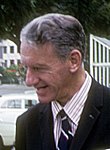Zimbabwe Rhodesia general election, 1979
|
|
||||||||||||||||||||||
|---|---|---|---|---|---|---|---|---|---|---|---|---|---|---|---|---|---|---|---|---|---|---|
|
||||||||||||||||||||||
|
All 100 seats in the House of Assembly |
||||||||||||||||||||||
|
||||||||||||||||||||||
|
||||||||||||||||||||||
The Zimbabwe Rhodesia general election of April 1979 was held under the Internal Settlement negotiated by the Rhodesian Front government of Ian Smith intended to provide a peaceful transition to majority rule on terms not harmful to Rhodesians of white descent. The internal settlement was not approved internationally but the incoming government under Bishop Abel Muzorewa did decide to participate in the Lancaster House talks which led to the end of the dispute and the creation of Zimbabwe.
Under the agreement of 1978, the new Zimbabwe Rhodesia House of Assembly was to consist of 100 members. 20 were to be elected on the old roll with property, income and education qualifications, which most black citizens did not meet, and which was previously used to elect the majority of the Rhodesia House of Assembly. 72 seats were elected by the "Common Roll" which every adult in the country had a vote. Owing to the lack of an electoral roll, voters were instead marked with ink on their fingers to stop multiple voting. Once the 92 members had been elected, they assembled to vote for eight White non-constituency members. All the candidates for these posts were members of the Rhodesian Front.
The 20 White Roll members were elected from new constituencies made up of combinations of the previous constituencies. The Common Roll members were elected by province using a closed list system. It was intended to set up a full electoral register and institute single-member constituencies for future elections.
The main question in the election campaign was how many Africans would vote in the common roll election. The Patriotic Front parties, Zimbabwe African National Union - Patriotic Front and Zimbabwe African People's Union, pledged to disrupt the election and called for a boycott. By 1979, all of Rhodesia apart from the central area between Salisbury and Bulawayo was under a form of martial law due to attacks by the Patriotic Front's armies, the Zimbabwe African National Liberation Army and Zimbabwe People's Revolutionary Army (ZIPRA).
...
Wikipedia


